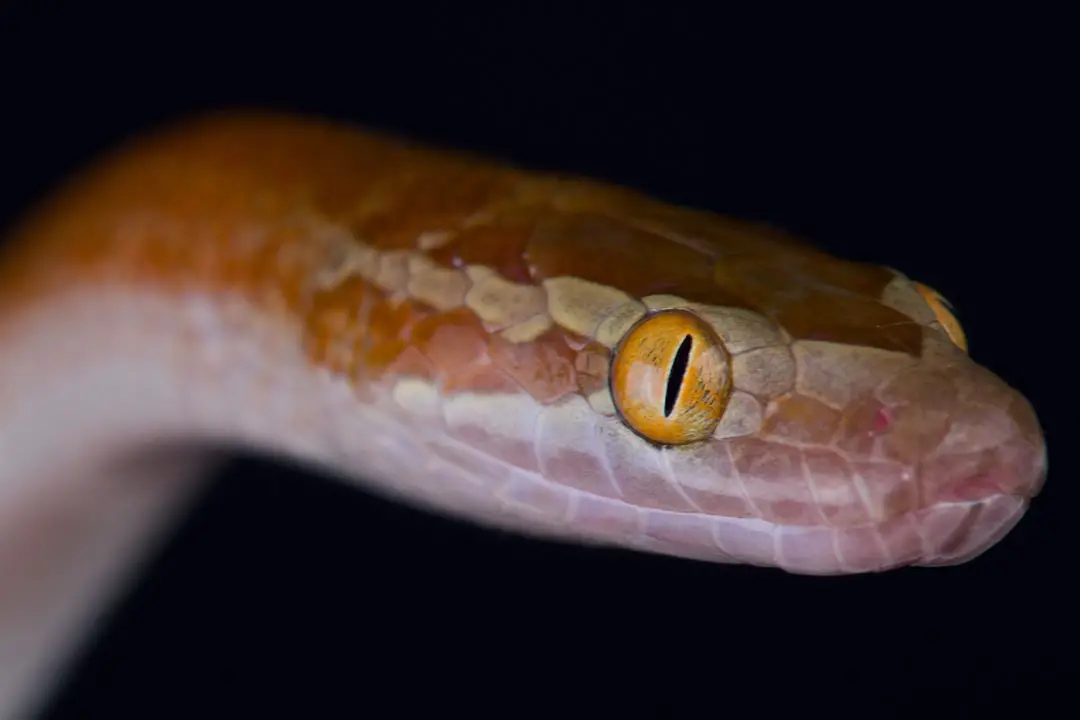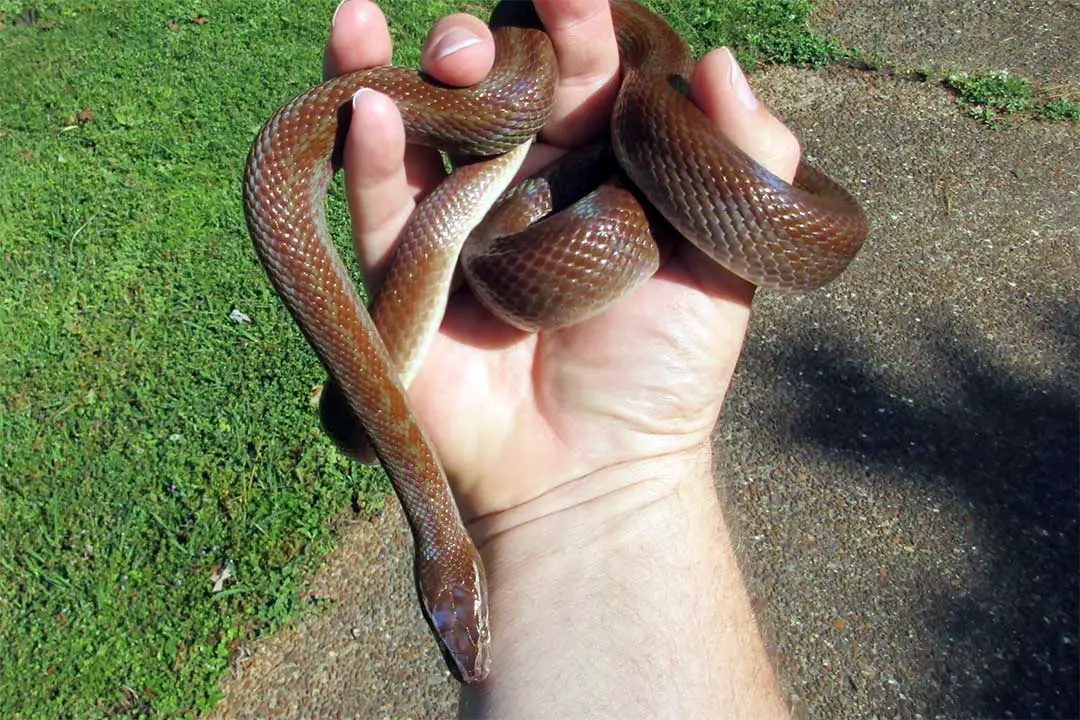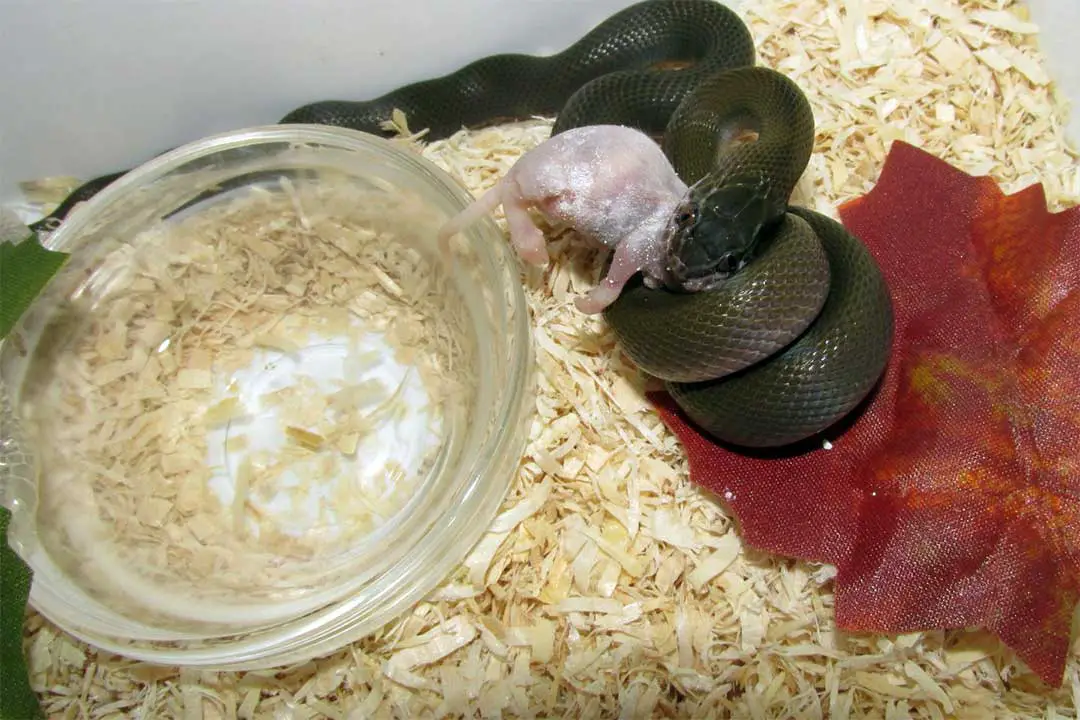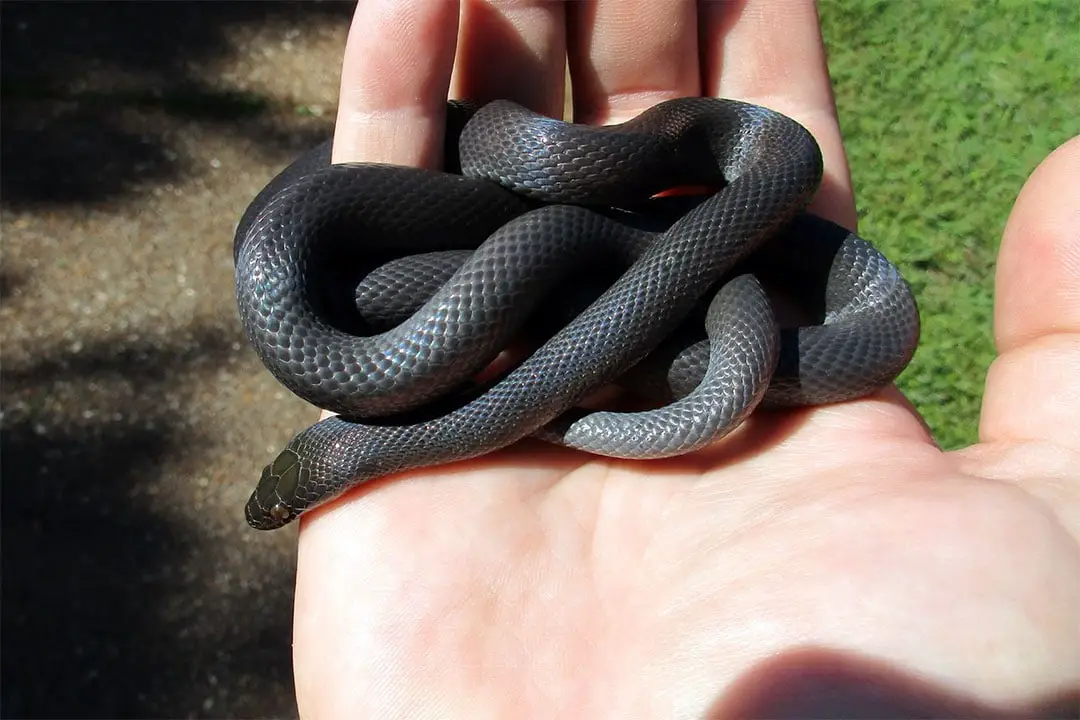African House Snakes – Boaedon fuliginosus – are some of the best captive pet snakes to keep because they are generally friendly, of a small size, and manageable to care for.
In this care sheet, I go through everything you need to know to properly take care of your African House Snake. Feel free to jump to any section by clicking in the table of contents below:
Housing
Creating the right environment for your African House Snake can go a long way, snakes need to be given enough space and the right living conditions in their enclosures. Here are the things you need to know about how to properly house your African House Snake.
Enclosure for Juvenile African House Snakes
If you want to properly house your snakelet or juvenile African House Snake, it is best to put it in its own separate enclosure the moment you get it.
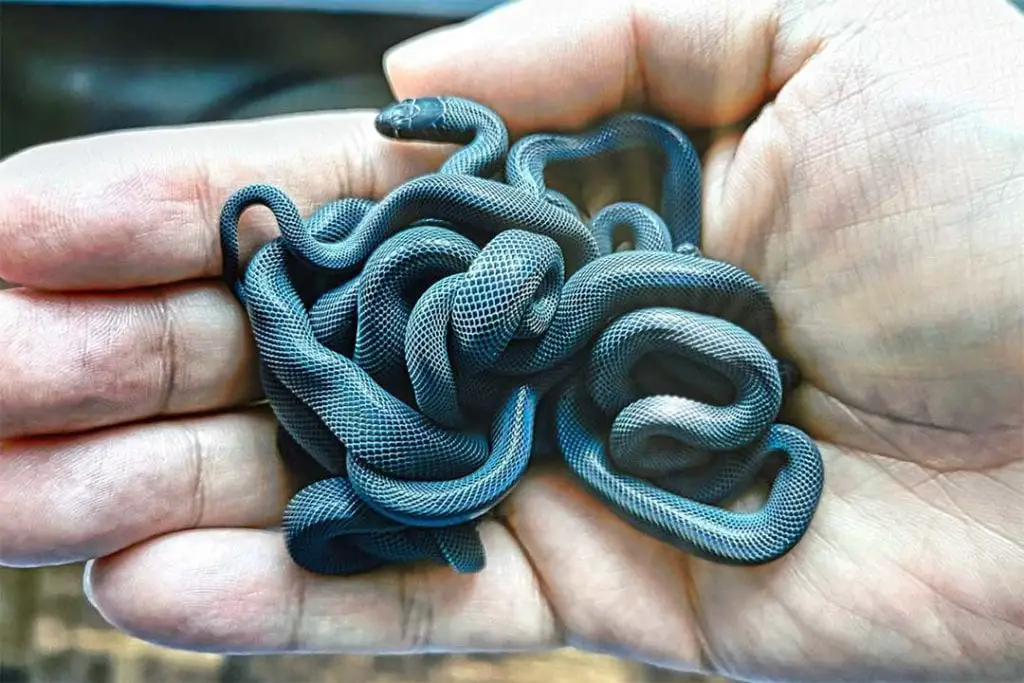
Some people choose to house their snakes in adult-sized enclosures even as snakelets, and I don’t mind doing that. After all, these snakes tend to grow up rather quickly, and you can keep them in one single environment so that they no longer need to adjust again later.
Juvenile African House Snakes can be somewhere between 8 to 16 inches long.
That said, the Exo Terra Short Glass Terrarium below will be great for your snakelet or juvenile snake.
That’s because it comes with a front-access panel that will reduce the stress that most baby or juvenile snakes tend to be under when they are fed from the top.
This enclosure also comes with special inlets where you can insert the wires you need for the heating pads.
Enclosure for Adult African House Snakes
While you can house your adult African House Snake in the same enclosure that it was in when it was still a juvenile, it doesn’t hurt to upgrade its habitat into something bigger and better when the snake has reached adulthood.

And while the standard enclosure size for most adult African House Snakes is at least 10 gallons, you are free to go for something bigger if you want your snake to be more comfortable.
I recommend the 50 gallons Reptizoo Reptile Glass Terrarium, if you want an effective and large enough living space for your African House Snake.
That said, I like this terrarium because it comes with good front access windows that will make feeding less stressful for your snake, amazing ventilation, and great spots where you can place and set up your heating elements.
Substrate
The substrate is an important part of your African House Snake’s terrarium because it allows it to have an environment that is as close to natural as possible.
A good substrate would be able to hold in moisture well enough so that your snake won’t experience an environment that is too dry for it, but should not rot, or contain too fine particles which can cause respiratory issues.
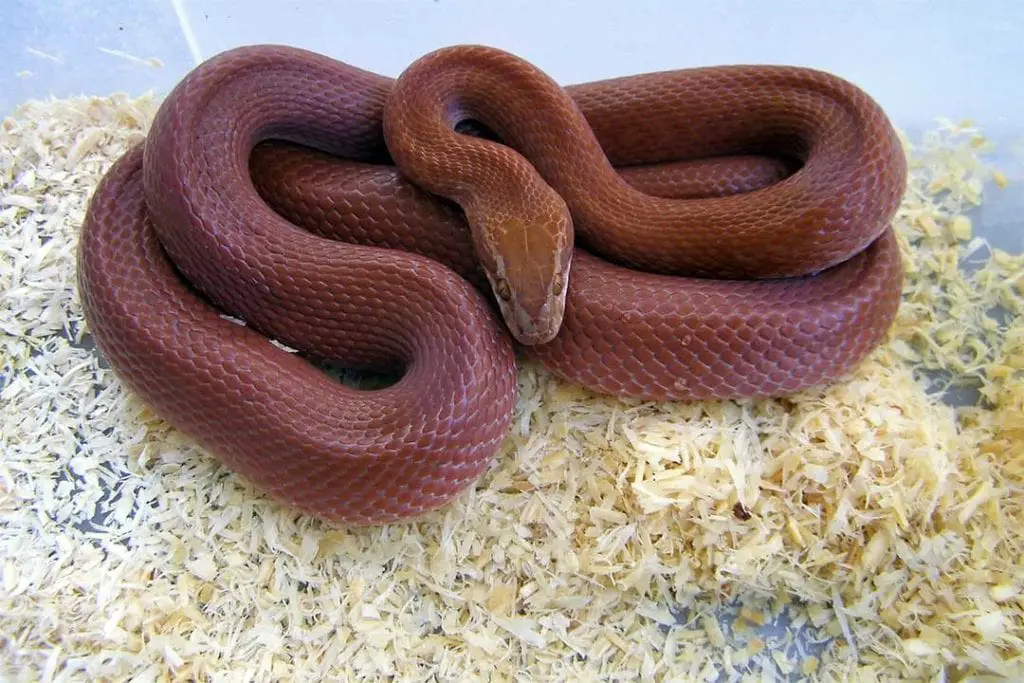
When it comes to a good substrate, I recommend Zoo Med Aspen Snake Bedding, which provides the snake with a natural substrate that comes from renewable sources. It is easy to clean and is pretty close to the same type of environment that your snake is used to.
If you want a good alternative, and a different look, there is ReptiChip’s Coconut Substrate, which makes use of coco chips to provide your snake with good bedding.
The pieces of this substrate are bigger and are great at keeping your snake’s enclosure humid enough for the reptile.
But it’s not the easiest substrate to clean, and aspen shavings will be better to quickly see and scoop out your snake’s waste.
Heating & temperature range
Heating is critical in a snake’s enclosure because snakesare cold-blooded animals and need the warmth of their environment to keep themselves warm.
And because the African House Snake is native to Africa and the Middle East, which can be quite hot, you need to make sure that your snake’s enclosure is pretty warm.
It is important to have a temperature gradient in the snake’s enclosure so that the reptile can regulate its own temperature.
Proper temperature gradient
African House Snakes need an environment that is at least 70 degrees Fahrenheit on the cooler end of the enclosure.
Meanwhile, on the warmer side, you can keep the temperatures at somewhere between 90 and 95 degrees Fahrenheit but not more than that.
Your African House Snake will want to stay on the warmer side when needed, and move to the colder side to cool down.
The easiest and most affordable way to heat the enclosure is to use the a heat pad that you place under the substrate, which is great at keeping temperatures in the warmer side steady enough.
The heating pad should be placed at the warm spot of the enclosure. Meanwhile, the excess heat in the warmer side will steadily create an ambient temperature that will keep the cool side somewhere close to 70 degrees.
Because the outside temperature fluctuates, and your enclosure can actually become too hot, you also need a thermostat to regulate the ambient temperatures in the African House Snake’s enclosure.
The Zoo Med RT 600 Thermostat comes in to automatically turn on your heating pad on the warm side of the enclosure when it gets a bit too cold for your reptile, and turn it off when it becomes too hot. This will maintain the right temperature:
Speaking of warmth, some people prefer to use ceramic heat bulbs to heat their enclosure. They can work as well, but I don’t prefer these for a couple of reasons.
These heat bulbs quickly become too hot and can end up drying the place too much or even burn your snakeIf placed incorrectly.
They are also not as energy efficient and will cost more electricity to run.
However, I still recommend that you use heat bulbs if you are in colder regions such as northern states or countries, or if the enclosure is placed in a cold room, because heating pads might not be able to provide sufficient heat for your snake.
But make sure that you do not put the heat bulb too close to the surface of your African House Snake’s enclosure or else you will be flirting with the risk of burning the snake, and you will need to mist the enclosure more frequently (especially when shedding).
Light
Unlike other reptiles, the African House Snake does not need a UVB light to stay healthy because it already gets enough vitamin D and calcium on a regular basis from their prey.
But it won’t hurt if you want to give it UVB lights. Then again, it really isn’t needed. Still, if you insist, neon lights might be good because they improve the habitat’s overall aesthetics.
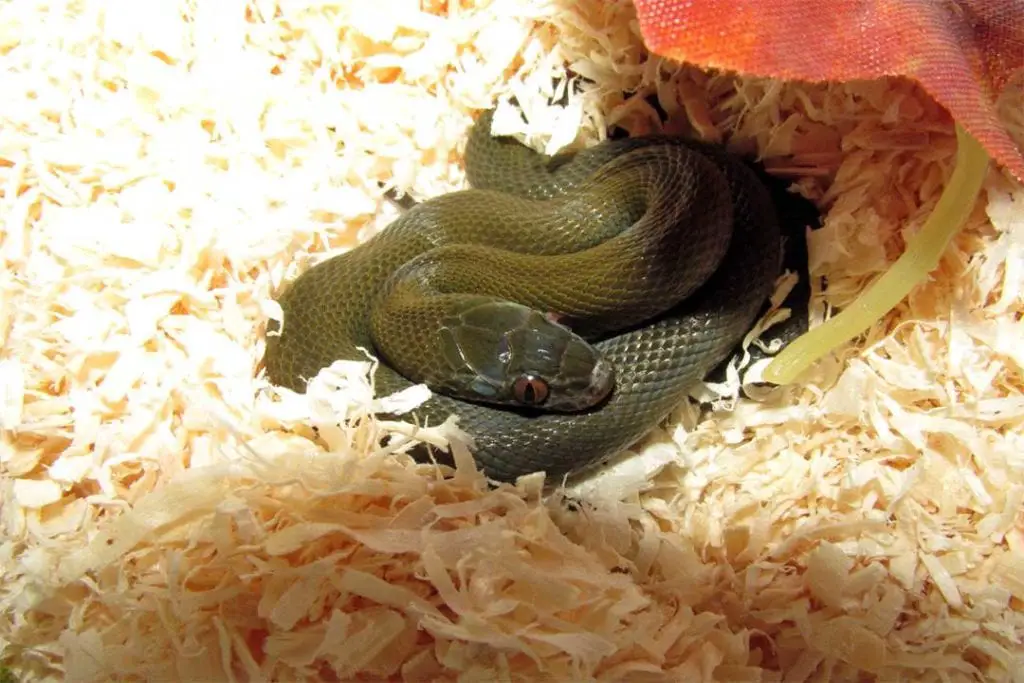
If your snake’s enclosure is in a cold room, you can also add a heat bulb to serve as the main heat and light source for your snake.
They will also provide a good basking area for your African House Snake in case it wants to bask right after eating.
But always make sure that you keep the enclosure humid enough because heat bulbs can be really effective at drying up an entire enclosure.
Shelter
African House Snakes prefer to find shelter in the wild as much as they possibly can.
Other than the fact that they are nocturnal animals that want to stay hidden during the day, these snakes are not apex predators in the sense that they also have natural predators that they want to hide from whether they may be birds of prey or bigger reptiles.
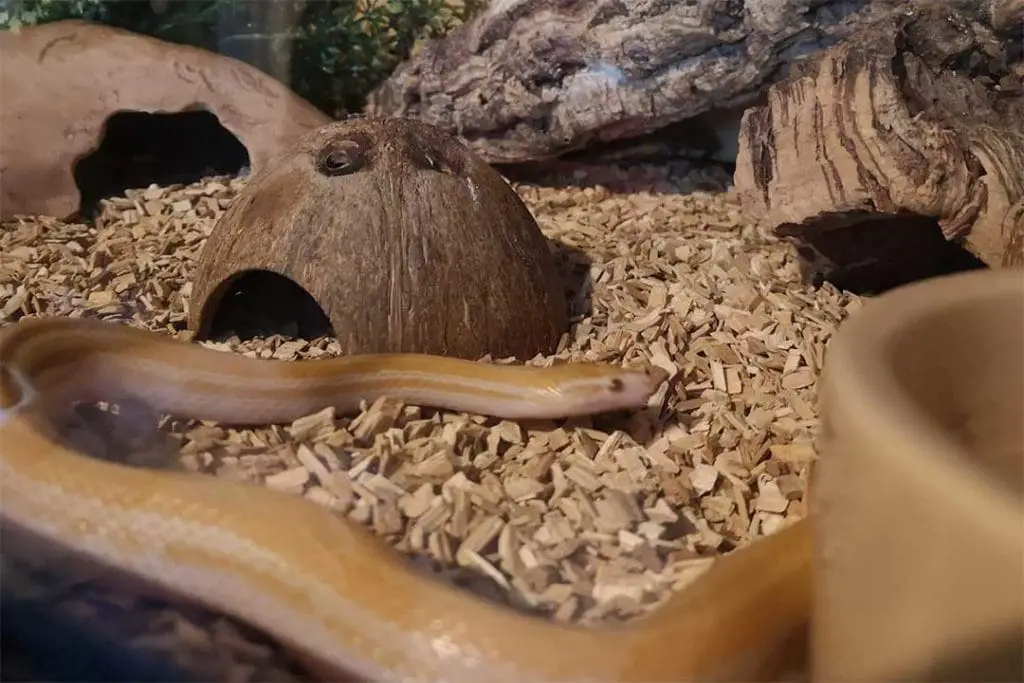
That said, your African House Snake is naturally inclined to try to hide during the day.
As a result, it is always recommended that you add decorations to your snake’s habitat due to the way it needs to hide itself when needed. That said, decorations are not merely for aesthetics as they actually serve a purpose.
You can use Zoo Med Reptile Shelter for your snake because it acts in a similar way as a cave whenever your African House Snake needs to keep itself hidden.
But you are free to use large rocks or driftwood if you can find some because these natural hiding places are also just as effective.
Water
African House Snakes love water, and that is one of the reasons why you should make sure to provide a good and big enough water bowl inside your snake’s enclosure.
Of course, let’s not forget about the fact that water is one of the most important requirements that any animal needs to survive.
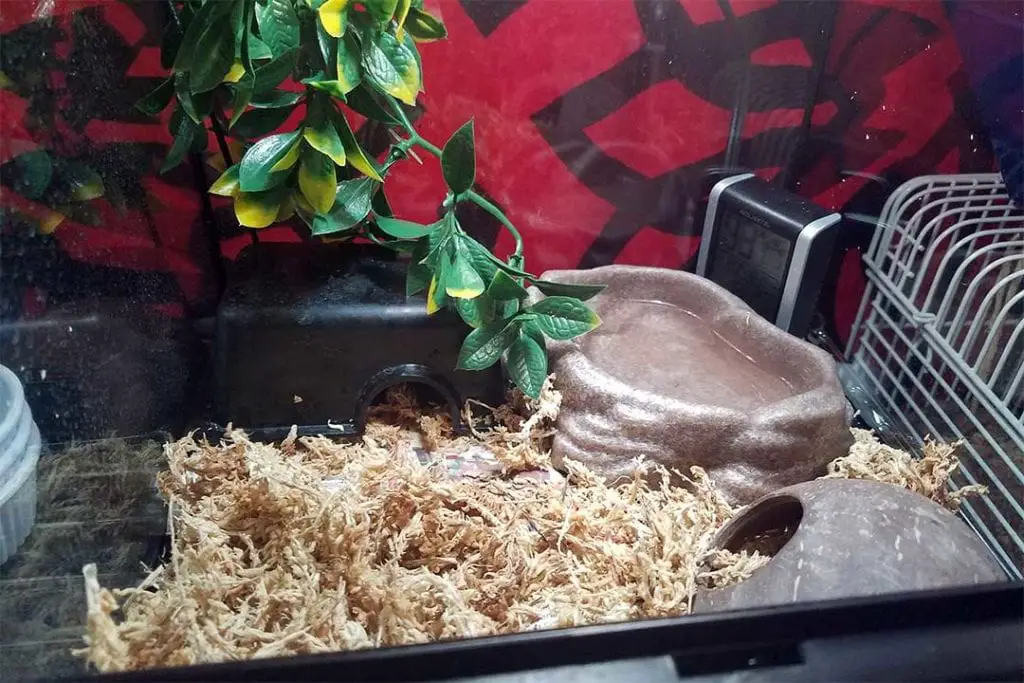
As such, keep a good water bowl such as Reptizoo Water Bowl inside the snake’s enclosure on the cool side to provide it with cool water to drink and to submerge its body in whenever it needs to.
You should also know that African House Snakes like staying in their water bowl during their shedding season because it allows them to shed better.
That’s why it is important to always keep the water bowl inside its enclosure. At the same time, you should replace the water every day and disinfect the bowl may once or twice a week.
Always make sure that your snake has fresh and clean water to drink by replacing its water regularly.
Humidity
Even though the African House Snake is used to the dry environments of Africa, that doesn’t mean that it doesn’t need some moisture in its enclosure’s air.
While the snake does not need high levels of humidity as compared to other snake species that are used to living in tropical environments, you still need to keep humidity levels in the enclosure somewhere between 30 and 50 percent because this allows the snake to keep its skin moist. (You can keep track of this with a simple hygrometer like this one placed inside the enclosure)
This is important whenever it’s time for the snake to shed as the extra moisture makes it easier for its skin to easily peel off whole.
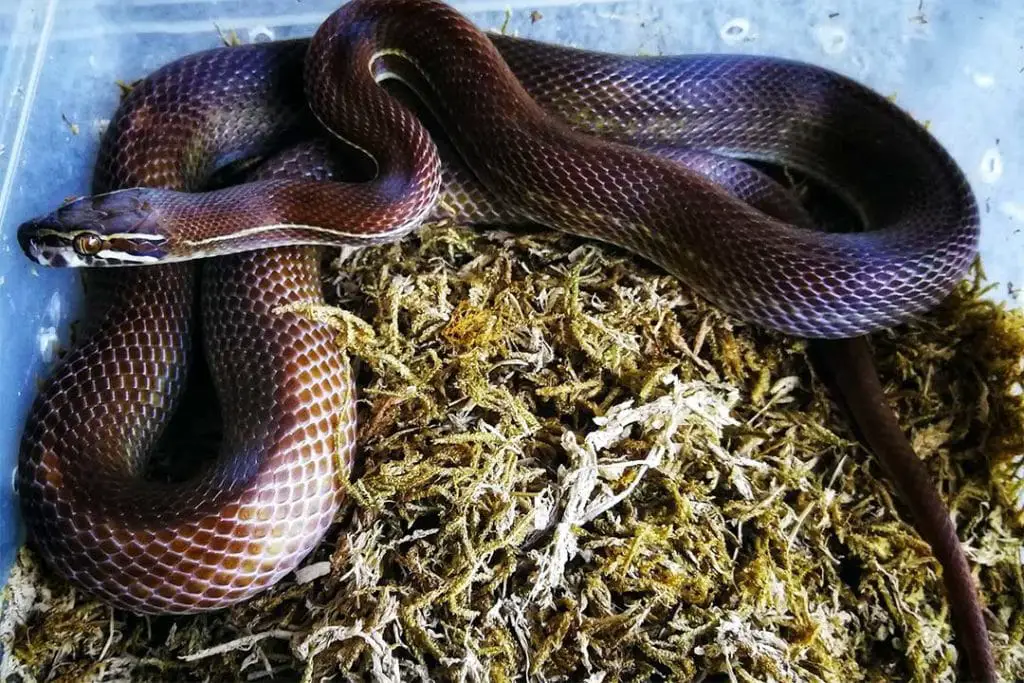
One of the best ways you can improve the humidity in the enclosure is through regular misting. You may want to mist the enclosure with water maybe once or twice a day.
Meanwhile, adding a bigger water bowl will also improve humidity levels if needed.
You can also add sphagnum moss such inside the snake’s hiding spot so that it will be able to shed easier due to how moss is great at holding moisture and improving humidity levels:
Enclosure maintenance
Finally, when it comes to giving your African House Snake the right kind of living environment, it will always be important for you to make sure that it lives in an enclosure that is as clean and sanitary as possible.
This is to ensure that we keep away germs, bacteria, and parasites that could cause illnesses, diseases, and other health problems. And the best way to provide the snake with a good and clean environment is to properly clean the enclosure regularly.
Here are some cleaning tips that should be helpful for you:
- Remove the African House Snake from the enclosure and house it in a backup tank that should provide it with a good living environment temporarily.
- Remove any of the decorations and the substrate from the enclosure. Disconnect the fixtures such as the heat pad or the lights from the enclosure as well.
- Spot-clean the entire tank and make sure that you clean all of the corners and the nooks and crannies.
- After spot-cleaning, the tank, use a mild solution that should be safe for your Boaedon fuliginosus. In some cases, a water and vinegar solution might be ideal if you don’t have a reptile cleaning product available.
- Spray the entire enclosure with the solution and wipe it off using a damp towel. This solution is supposed to disinfect the entire tank.
- Get a separate towel that is dry and use it to wipe off any of the excess moisture in the tank. After that, leave the enclosure open and exposed to air-dry it for about a day.
- After air-drying the tank, return the substrate, the fixtures, and all of the decorations.
- Return the snake once everything is back in order.
Meanwhile, when we are talking about the African House Snake’s substrate, you may be able to spot-clean it every once in a while by removing any excess skin or feces on it.
However, it still is best to replace the substrate every 4 or so months to make sure that the reptile’s environment is as clean as it can be.
Feeding your African House Snake
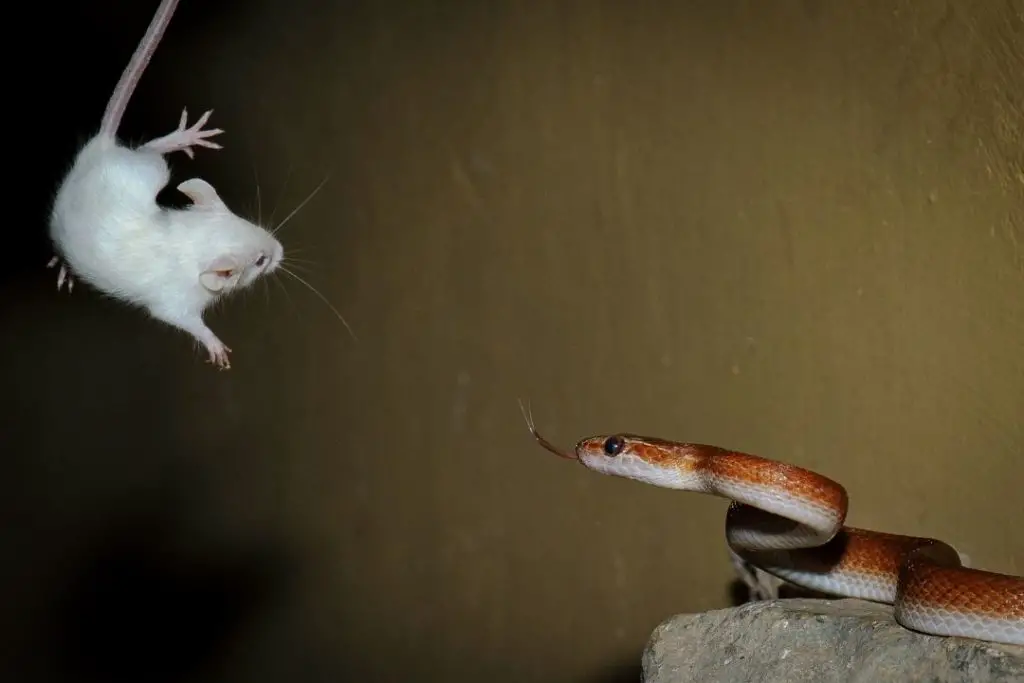
Feeding your African House Snake the right kind of diet goes a long way in making sure that this reptile stays healthy and happy throughout its entire lifetime.
That said, you won’t have a lot of problems when it comes to feeding your snake as long as you know the basics.
Type and size of prey
It is actually quite easy to make sure that your African House Snake is healthy in terms of its diet because it can live well enough on a diet that is composed of rodents.
You can provide your snake with domesticated mice or rats but you can also give it a gerbil or a hamster every now and then depending on your snake’s mood.
Young African House Snakes that are still at the infancy stage are already big enough to eat pinky mice because they are most likely somewhere between 8 to 12 inches long already.
However, it is best to wait until the baby snake has shed before you feed it the first time. After that, feed it with pinky mice.
As your African House Snake grows bigger and older, you should also upgrade the size of its meals until it is ready to take on full-grown domesticated mice.
An adult brown house Snake should thrive well on full-grown domesticated mice or even a rat. In most cases, these snakes should be able to do well on a mouse that is about 30 grams heavy.
You can also give it a rat if you can. It is best to feed an adult-sized African House Snake with about 24 to 30 grams of rodents pear meal.
Frozen vs live

The debate between frozen and live is actually something that reptile keepers tend to talk about more and more because of how it can be quite polarizing. While we do support feeding your African House Snake with frozen food, let’s still look at all of the arguments of both sides.
Feeding your snake with frozen food will allow you to easily store the food in a freezer or freezer drawer that’s dedicated to storing your snake’s food.
This allows you to have a constant food supply for your African House Snake without taking up too much storage space or effort on your part.
It is also safer for you to feed your snake with frozen rodents because they are already dead and won’t end up fighting back when your snake tries to eat them.
And it is also more humane to feed your snake with frozen rodents because the mice no longer have to experience the pain of getting eaten alive by a snake.
On the other hand, there are some African House Snakes that are used to their natural instincts as hunters that it would be difficult for them to accept frozen food.
You might have to poke them a bit with their food so that you would end up convincing them to eat.
So, those who support feeding live prey to their lamprophis snake find that the snakes are more willing to accept eating their prey because it is in line with their natural instincts as hunters.
However, it can be dangerous to feed your snake with live prey because of the very fact that there is a chance of ending up with an injured reptile when the rodent tries to fight back.
Storing the rodents can also be difficult because you have to put them in a separate cage and actually feed them well enough. And it might not be the most humane act for you to feed and take care of these rodents only to feed them to a snake later on.
That said, it might be better for you to choose to feed your African House Snake frozen food because of how it is safer and more humane.
There might be some problems with trying to make your snake accept its meal but that won’t be a problem later on once it has already gotten used to eating frozen food.
How you should feed your African house snake
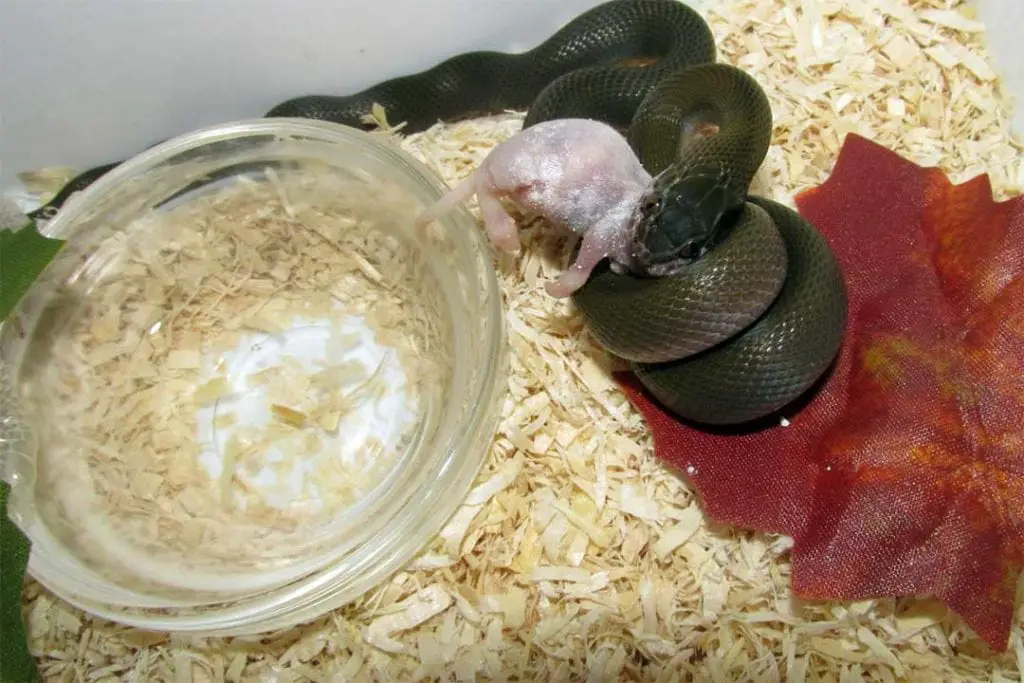
Make sure that you follow a proper feeding schedule for your African House Snake because it can end up malnourished if you don’t feed it properly or too fat and overweight if you feed it too often.
For baby African House Snakes, you can feed them more frequently because they need the food for growth. They should be able to thrive on a single pinky mouse maybe once every 4 to 5 days.
But you may want to increase the portion sizes as the snake grows bigger. Most juveniles may be able to take at least 2 pinky mice every 4 to 5 days.
As the African House Snake transitions from its juvenile stage to young adulthood, you can give it 2 or 3 pinky mice or one fuzzy mouse depending on how large it has become.
Give it a fuzzy mouse every 5 to 6 days but you can increase the portion size if you have a bigger and older African House Snake.
Adult House Snakes will be able to thrive well on a full-grown domesticated mouse. Male snakes should be able to go without eating for 14 days but you should give it a meal maybe once every 7 to 14 days depending on how large its last meal was.
Meanwhile, females go hungry faster because they are bigger. That’s why you need to feed your female African House Snake a full-grown adult mouse once a week.
Shedding
African House Snakes are like any other snake in the sense that they will continue to grow as they age. Due to that, they would need to shed their old skin to grow a new one that fits their growing bodies.
Most of these snakes may shed maybe once every 2 to 4 months depending on the rate of their growth.
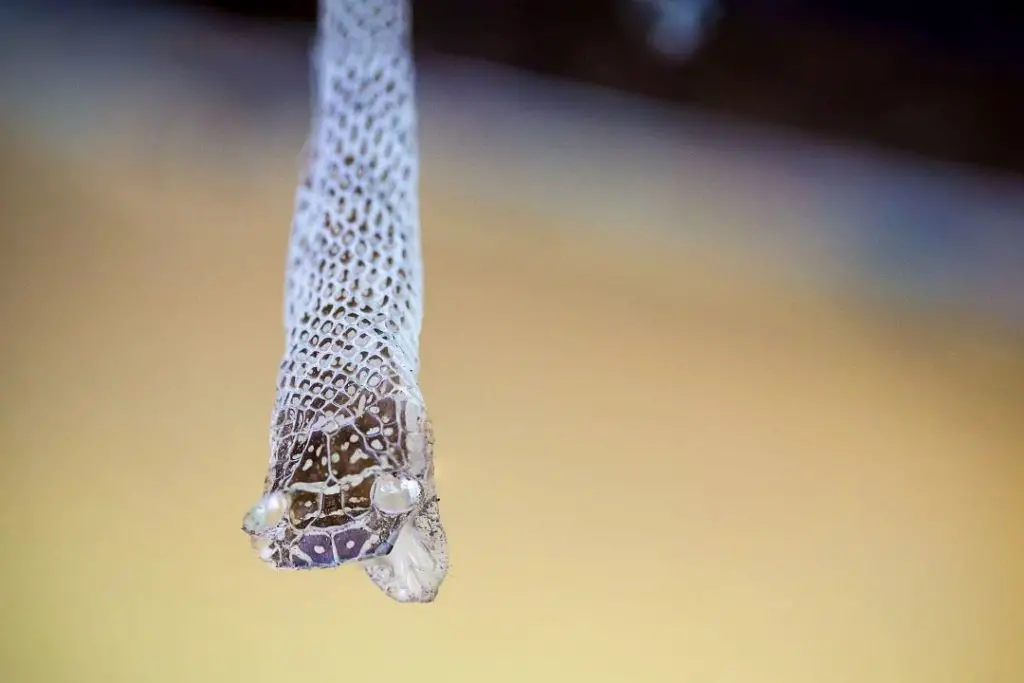
When you want to give your snake a stress-free shed, it is best to make sure that it is in an environment that is quite humid. This is where putting a large water dish can help it shed its skin well enough as African House Snakes love staying in the water whenever they are shedding due to how the excess moisture allows them to easily shed without pain and difficulties.
They also love staying in hiding boxes due to how stressful shedding can be, and that is why you have to make sure that the enclosure is humid enough by misting it with water regularly.
Always check your snake to see if it has already peeled off all of its skin. As soon as you have seen that it has shed all of its old skin, remove the skin to prevent any infections.
However, it is not uncommon for snakes to have remaining skin near the eyes. At this point, the snake will be more receptive to getting handled, which will make it easier for you to remove the skin near its eyes so that you can prevent any infection.
Hibernation
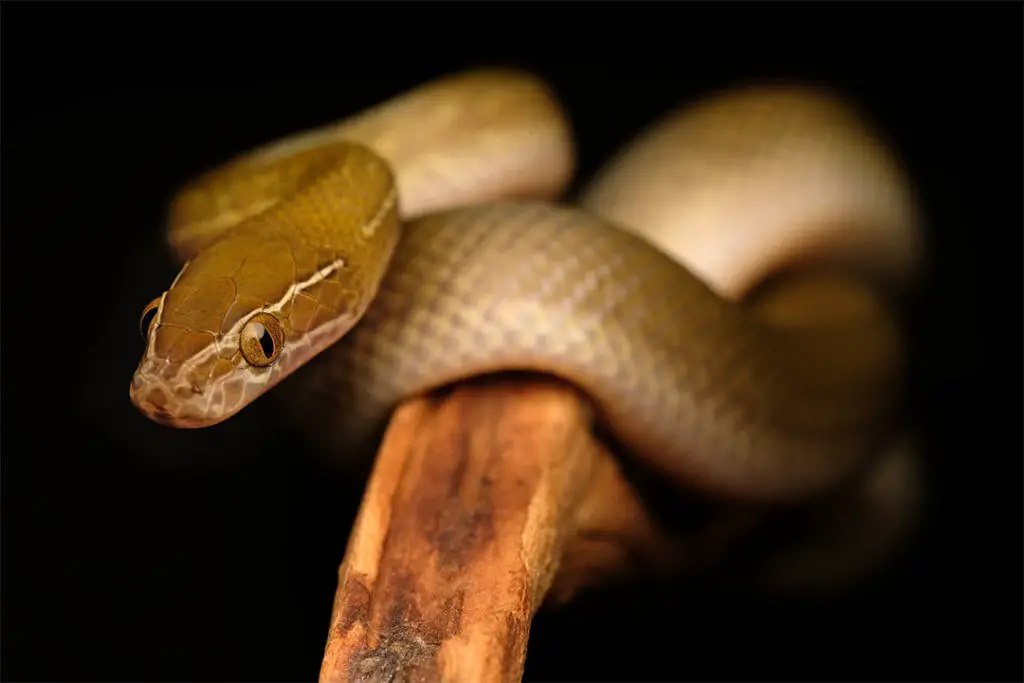
It is not common for Brown House Snakes to hibernate in the wild because they don’t live in areas that experience winters frequently.
That’s why you should never try to let your African House Snake hibernate during the winter unless you are planning on breeding your snakes. But, if you don’t want them to hibernate during winter, always keep the temperature in the enclosure up near normal.
It would be perfectly normal for temperatures to drop maybe about 5 degrees during winter. This will lead to a bit of inactivity on the part of your African House Snake due to the reduced light cycle and the changes in the temperature. But, as long as the temperatures don’t drop too low, it won’t end up hibernating.
Still, you will notice how it won’t be as active or as voracious of an eater as it was before, and that is why you might want to cut down the meals you are giving the snake during winter.
Tips to handle your African house snake
Handling an African House Snake is quite easy because these snakes are quite calm and are pretty much docile and submissive as long as you don’t do anything reckless. That said, here are some handling tips when it comes to African House Snakes:
- Don’t come at them too fast and make sure that you do so slowly. African House Snakes can get easily startled when you try to handle them right off the bat.
- When carrying the snake, make sure that you support all of its weight so that it will feel safe in your hands.
- Don’t grip the snake too tightly or else it will think you are a predator. It might end up retaliating if your grip is too tight.
- Avoid handling the snake maybe 2 days before and after its meal.
- Don’t handle your African House Snake during its shedding season because of how it will be under a lot of stress.
- Similarly, avoid handling a pregnant African House Snake.
- Always wash your hands before handling your African House Snake.
- Don’t worry if you actually get bitten, which can be quite rare when it comes to these snakes. African House Snakes are nonvenomous and rarely bite. Just wash the injured part with soap and water to disinfect it properly.
Common issues
Why isn’t my House snake not eating?
Your African House Snake might not be eating because it is not used to frozen food or maybe because it is ill. Try poking it with its food using forceps. Or, if it is ill, take it to the vet immediately.
Why is my Snake regurgitating its food?
Regurgitation often happens in snakes when they ate a previous meal that may be too big for them.
Boaedon Fuliginosus common diseases
Respiratory problems can be common in sub saharan africa when the temperatures are too low. Also, make sure that you wash your hands before handling the snake and that you clean its enclosure as often as you can to prevent bacteria and parasites from building up.
Final words
It might be true that the African House Snake care is quite easy for most beginners and novice reptile owners. However, the fact remains that knowledge and preparation are still very much important when taking care of any snake or pet, in general.
That’s why you need to make sure that you learn more about how to properly care for your pet snake in every facet such as its housing and food if you want to have a pet reptile that gets to live out its entire lifespan to the fullest.
Sources
- The diet of African house snakes (Boaedon spp) revealed by citizen science – The Herpetological Bulletin 143, 2018: 34-35
- A developmental staging series for the African house snake, Boaedon (Lamprophis) fuliginosus – Scott M Boback , Eric K Dichter, Hemlata L Mistry
References:
- Branch, B. 1988. A field guide to the snakes and other reptiles of southern Africa. Ralph Curtis, Signable Island, Florida. pp. 58-60.
- Fitzsimmons, V.F.M. 1962. Snakes of southern Africa. MacDonald and Co., Ltd., London. pp. 116-123.
- Putnam, C.R.S. 1974. A guide to the snakes of Uganda. Codicote, Weldon and Wesley, Ltd. pp. 77-81.
- Roman, B. 1980. Serpents de Haute-Volta (Snakes of Upper Volta). C.N.R.S.T., Ouagadougou, Upper Volta. pp. 83-85. (in French)
- Sweeney, R.C.H. 1971. Snakes of Nyasaland: with new added corrigenda and addenda. A. Asher and Co. N.V., Amsterdam. pp. 51-53.
- Trutnau, L. 1986. Non-venomous Snakes. Barron’s, Woodbury, New York. pp. 91-92.
- Welch, K.R.G. 1982. Herpetology of Africa: A checklist and bibliography of the orders Amphisbaenia, Sauria, and Serpentes. Robert E. Krieger Publishing Co., Malabar, Florida. pp 151-152.
